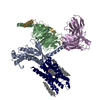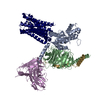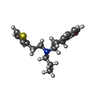+ Open data
Open data
- Basic information
Basic information
| Entry | Database: PDB / ID: 8irs | ||||||
|---|---|---|---|---|---|---|---|
| Title | Dopamine Receptor D2R-Gi-Rotigotine complex | ||||||
 Components Components |
| ||||||
 Keywords Keywords | MEMBRANE PROTEIN / Dopamine / Dopamine receptor / GPCR / D2R / Gi / Rotigotine / Polypharmacology Parkinson's disease / Restless legs syndrome | ||||||
| Function / homology |  Function and homology information Function and homology informationnegative regulation of dopamine receptor signaling pathway / positive regulation of dopamine uptake involved in synaptic transmission / negative regulation of dephosphorylation / negative regulation of circadian sleep/wake cycle, sleep / positive regulation of glial cell-derived neurotrophic factor production / acid secretion / dopamine neurotransmitter receptor activity, coupled via Gi/Go / nervous system process involved in regulation of systemic arterial blood pressure / response to histamine / regulation of synapse structural plasticity ...negative regulation of dopamine receptor signaling pathway / positive regulation of dopamine uptake involved in synaptic transmission / negative regulation of dephosphorylation / negative regulation of circadian sleep/wake cycle, sleep / positive regulation of glial cell-derived neurotrophic factor production / acid secretion / dopamine neurotransmitter receptor activity, coupled via Gi/Go / nervous system process involved in regulation of systemic arterial blood pressure / response to histamine / regulation of synapse structural plasticity / regulation of locomotion involved in locomotory behavior / neuron-neuron synaptic transmission / adenohypophysis development / negative regulation of dopamine secretion / positive regulation of renal sodium excretion / negative regulation of cellular response to hypoxia / hyaloid vascular plexus regression / adenylate cyclase-inhibiting dopamine receptor signaling pathway / response to inactivity / regulation of potassium ion transport / orbitofrontal cortex development / cerebral cortex GABAergic interneuron migration / Dopamine receptors / negative regulation of neuron migration / dopamine binding / branching morphogenesis of a nerve / regulation of dopamine uptake involved in synaptic transmission / positive regulation of growth hormone secretion / phospholipase C-activating dopamine receptor signaling pathway / peristalsis / heterotrimeric G-protein binding / drinking behavior / G protein-coupled receptor complex / grooming behavior / behavioral response to ethanol / auditory behavior / positive regulation of G protein-coupled receptor signaling pathway / striatum development / dopaminergic synapse / positive regulation of urine volume / positive regulation of multicellular organism growth / G protein-coupled receptor internalization / negative regulation of synaptic transmission, glutamatergic / non-motile cilium / heterocyclic compound binding / response to iron ion / adult walking behavior / arachidonate secretion / response to morphine / ciliary membrane / negative regulation of cytosolic calcium ion concentration / regulation of synaptic transmission, GABAergic / temperature homeostasis / pigmentation / positive regulation of neuroblast proliferation / positive regulation of cytokinesis / dopamine uptake involved in synaptic transmission / regulation of dopamine secretion / dopamine metabolic process / cellular response to ethanol / response to light stimulus / associative learning / positive regulation of receptor internalization / lateral plasma membrane / endocytic vesicle / G-protein alpha-subunit binding / neuroblast proliferation / negative regulation of protein secretion / long-term memory / potassium channel regulator activity / sperm flagellum / prepulse inhibition / response to axon injury / postsynaptic modulation of chemical synaptic transmission / adenylate cyclase inhibitor activity / behavioral response to cocaine / positive regulation of protein localization to cell cortex / regulation of sodium ion transport / T cell migration / Adenylate cyclase inhibitory pathway / negative regulation of blood pressure / synapse assembly / D2 dopamine receptor binding / response to prostaglandin E / cellular response to retinoic acid / adenylate cyclase regulator activity / G protein-coupled serotonin receptor binding / adenylate cyclase-inhibiting serotonin receptor signaling pathway / axon terminus / release of sequestered calcium ion into cytosol / ionotropic glutamate receptor binding / presynaptic modulation of chemical synaptic transmission / cellular response to forskolin / acrosomal vesicle / negative regulation of phosphatidylinositol 3-kinase/protein kinase B signal transduction / axonogenesis / regulation of heart rate / regulation of mitotic spindle organization / negative regulation of innate immune response / negative regulation of cell migration Similarity search - Function | ||||||
| Biological species |  Homo sapiens (human) Homo sapiens (human)  | ||||||
| Method | ELECTRON MICROSCOPY / single particle reconstruction / cryo EM / Resolution: 3 Å | ||||||
 Authors Authors | Xu, P. / Huang, S. / Zhuang, Y. / Mao, C. / Zhang, Y. / Wang, Y. / Li, H. / Jiang, Y. / Zhang, Y. / Xu, H.E. | ||||||
| Funding support |  China, 1items China, 1items
| ||||||
 Citation Citation |  Journal: Cell Res / Year: 2023 Journal: Cell Res / Year: 2023Title: Structural genomics of the human dopamine receptor system. Authors: Peiyu Xu / Sijie Huang / Brian E Krumm / Youwen Zhuang / Chunyou Mao / Yumu Zhang / Yue Wang / Xi-Ping Huang / Yong-Feng Liu / Xinheng He / Huadong Li / Wanchao Yin / Yi Jiang / Yan Zhang / ...Authors: Peiyu Xu / Sijie Huang / Brian E Krumm / Youwen Zhuang / Chunyou Mao / Yumu Zhang / Yue Wang / Xi-Ping Huang / Yong-Feng Liu / Xinheng He / Huadong Li / Wanchao Yin / Yi Jiang / Yan Zhang / Bryan L Roth / H Eric Xu /   Abstract: The dopaminergic system, including five dopamine receptors (D1R to D5R), plays essential roles in the central nervous system (CNS); and ligands that activate dopamine receptors have been used to ...The dopaminergic system, including five dopamine receptors (D1R to D5R), plays essential roles in the central nervous system (CNS); and ligands that activate dopamine receptors have been used to treat many neuropsychiatric disorders, including Parkinson's Disease (PD) and schizophrenia. Here, we report cryo-EM structures of all five subtypes of human dopamine receptors in complex with G protein and bound to the pan-agonist, rotigotine, which is used to treat PD and restless legs syndrome. The structures reveal the basis of rotigotine recognition in different dopamine receptors. Structural analysis together with functional assays illuminate determinants of ligand polypharmacology and selectivity. The structures also uncover the mechanisms of dopamine receptor activation, unique structural features among the five receptor subtypes, and the basis of G protein coupling specificity. Our work provides a comprehensive set of structural templates for the rational design of specific ligands to treat CNS diseases targeting the dopaminergic system. | ||||||
| History |
|
- Structure visualization
Structure visualization
| Structure viewer | Molecule:  Molmil Molmil Jmol/JSmol Jmol/JSmol |
|---|
- Downloads & links
Downloads & links
- Download
Download
| PDBx/mmCIF format |  8irs.cif.gz 8irs.cif.gz | 417.2 KB | Display |  PDBx/mmCIF format PDBx/mmCIF format |
|---|---|---|---|---|
| PDB format |  pdb8irs.ent.gz pdb8irs.ent.gz | 339.9 KB | Display |  PDB format PDB format |
| PDBx/mmJSON format |  8irs.json.gz 8irs.json.gz | Tree view |  PDBx/mmJSON format PDBx/mmJSON format | |
| Others |  Other downloads Other downloads |
-Validation report
| Summary document |  8irs_validation.pdf.gz 8irs_validation.pdf.gz | 1.2 MB | Display |  wwPDB validaton report wwPDB validaton report |
|---|---|---|---|---|
| Full document |  8irs_full_validation.pdf.gz 8irs_full_validation.pdf.gz | 1.2 MB | Display | |
| Data in XML |  8irs_validation.xml.gz 8irs_validation.xml.gz | 37.2 KB | Display | |
| Data in CIF |  8irs_validation.cif.gz 8irs_validation.cif.gz | 57.2 KB | Display | |
| Arichive directory |  https://data.pdbj.org/pub/pdb/validation_reports/ir/8irs https://data.pdbj.org/pub/pdb/validation_reports/ir/8irs ftp://data.pdbj.org/pub/pdb/validation_reports/ir/8irs ftp://data.pdbj.org/pub/pdb/validation_reports/ir/8irs | HTTPS FTP |
-Related structure data
| Related structure data |  35684MC  8irrC  8irtC  8iruC  8irvC M: map data used to model this data C: citing same article ( |
|---|---|
| Similar structure data | Similarity search - Function & homology  F&H Search F&H Search |
- Links
Links
- Assembly
Assembly
| Deposited unit | 
|
|---|---|
| 1 |
|
- Components
Components
-Guanine nucleotide-binding protein ... , 3 types, 3 molecules ABG
| #1: Protein | Mass: 40414.047 Da / Num. of mol.: 1 Source method: isolated from a genetically manipulated source Source: (gene. exp.)  Homo sapiens (human) / Gene: GNAI1 / Production host: Homo sapiens (human) / Gene: GNAI1 / Production host:  Trichoplusia ni (cabbage looper) / References: UniProt: P63096 Trichoplusia ni (cabbage looper) / References: UniProt: P63096 |
|---|---|
| #2: Protein | Mass: 37915.496 Da / Num. of mol.: 1 Source method: isolated from a genetically manipulated source Source: (gene. exp.)  Homo sapiens (human) / Gene: GNB1 / Production host: Homo sapiens (human) / Gene: GNB1 / Production host:  Trichoplusia ni (cabbage looper) / References: UniProt: P62873 Trichoplusia ni (cabbage looper) / References: UniProt: P62873 |
| #4: Protein | Mass: 7861.143 Da / Num. of mol.: 1 Source method: isolated from a genetically manipulated source Source: (gene. exp.)  Homo sapiens (human) / Gene: GNG2 / Production host: Homo sapiens (human) / Gene: GNG2 / Production host:  Trichoplusia ni (cabbage looper) / References: UniProt: P59768 Trichoplusia ni (cabbage looper) / References: UniProt: P59768 |
-Antibody / Protein / Non-polymers , 3 types, 3 molecules ER

| #3: Antibody | Mass: 26466.486 Da / Num. of mol.: 1 Source method: isolated from a genetically manipulated source Source: (gene. exp.)   Trichoplusia ni (cabbage looper) Trichoplusia ni (cabbage looper) |
|---|---|
| #5: Protein | Mass: 67234.578 Da / Num. of mol.: 1 Source method: isolated from a genetically manipulated source Source: (gene. exp.)   Homo sapiens (human) Homo sapiens (human)Gene: cybC, DRD2 / Production host:  Trichoplusia ni (cabbage looper) / References: UniProt: P0ABE7, UniProt: P14416 Trichoplusia ni (cabbage looper) / References: UniProt: P0ABE7, UniProt: P14416 |
| #6: Chemical | ChemComp-R5F / |
-Details
| Has ligand of interest | Y |
|---|---|
| Has protein modification | Y |
-Experimental details
-Experiment
| Experiment | Method: ELECTRON MICROSCOPY |
|---|---|
| EM experiment | Aggregation state: PARTICLE / 3D reconstruction method: single particle reconstruction |
- Sample preparation
Sample preparation
| Component | Name: Dopamine Receptor D2R-Gi-Rotigotine complex / Type: COMPLEX / Entity ID: #1-#5 / Source: MULTIPLE SOURCES |
|---|---|
| Source (natural) | Organism:  Homo sapiens (human) Homo sapiens (human) |
| Source (recombinant) | Organism:  Trichoplusia ni (cabbage looper) Trichoplusia ni (cabbage looper) |
| Buffer solution | pH: 7.4 |
| Specimen | Embedding applied: NO / Shadowing applied: NO / Staining applied: NO / Vitrification applied: YES |
| Vitrification | Cryogen name: ETHANE-PROPANE |
- Electron microscopy imaging
Electron microscopy imaging
| Experimental equipment |  Model: Titan Krios / Image courtesy: FEI Company |
|---|---|
| Microscopy | Model: FEI TITAN KRIOS |
| Electron gun | Electron source:  FIELD EMISSION GUN / Accelerating voltage: 300 kV / Illumination mode: FLOOD BEAM FIELD EMISSION GUN / Accelerating voltage: 300 kV / Illumination mode: FLOOD BEAM |
| Electron lens | Mode: BRIGHT FIELD / Nominal defocus max: 3000 nm / Nominal defocus min: 1200 nm / Cs: 2.7 mm |
| Image recording | Electron dose: 60 e/Å2 / Film or detector model: GATAN K3 (6k x 4k) |
- Processing
Processing
| CTF correction | Type: PHASE FLIPPING AND AMPLITUDE CORRECTION |
|---|---|
| 3D reconstruction | Resolution: 3 Å / Resolution method: FSC 0.143 CUT-OFF / Num. of particles: 140237 / Symmetry type: POINT |
 Movie
Movie Controller
Controller







 PDBj
PDBj

































